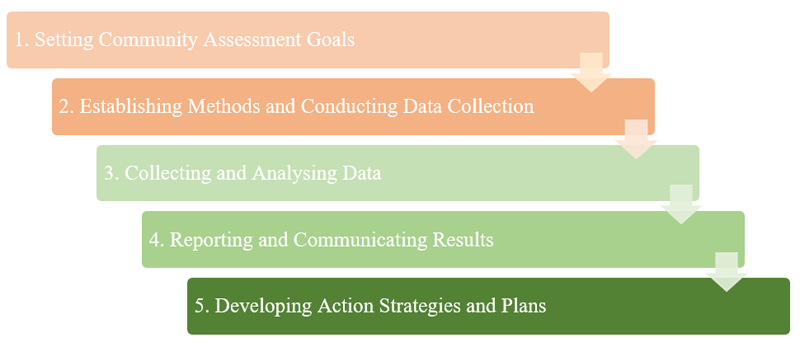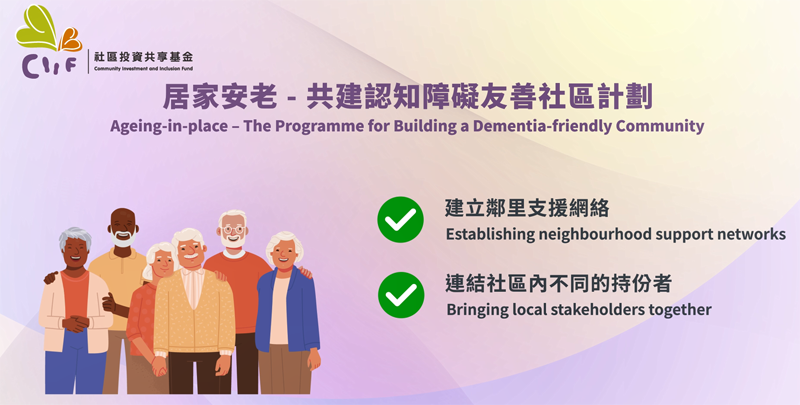Section Two: How to Implement Social Capital
How to Plan Social Capital Development Programs
Implementing social capital development programs requires relevant project teams to carefully plan and formulate intervention strategies before and during implementing the program. This ensures effective engagement and organisation of residents in the target community, encourages community participation, establishes mutual help social networks, promotes the development of social capital, and sustains its impact. The detailed relevant practical knowledge and intervention strategies to assist project teams in devising and formulating social capital development programs will be introduced as follows.
Identifying the Needs and Assets of the Community/Project Targets
Need-based and Asset-based Community Development
The primary step in formulating social capital development programs and effective intervention strategies is identifying community needs and assessing resources/assets. The need-based approach primarily focuses on responding to community needs and solving community problems. This involves assessing, identifying, and analysing community needs and problems, and seeking solutions (Mathie & Cunningham, 2003).
On the other hand, the Asset-based Community Development (ABCD) approach emphasises identifying and leveraging the strengths, skills, resources, and networks within the community to promote community capacity building and social capital development (Kretzmann & McKnight, 1993). The advantage of this approach is that it views each community as possessing unique assets rather than focusing solely on community problems. It encourages the transformation of community members' roles and the development of community capacity (Mathie & Cunningham, 2003). During development, the project team can collaborate with community members to identify and assess the community's assets. For example, they can work together to create a community asset map that records the skills, expertise, social networks, organisations, and resources of different community members in detail, assisting in formulating social capital development strategies.
Scholars emphasise the importance of integrating both approaches and believe that responding to community needs and building community assets should be the foundation for promoting community members’ participation and the development of social capital in a more comprehensive manner (Minkler & Wallerstein, 2012) (Figure 10).

Key Steps in Community Assessment
Community assessment is one of the critical processes in formulating and implementing social capital development programs (see Figure 11). The project team may identify community needs and assets to set program goals and design effective intervention strategies (Delgado & Humm-Delgado, 2013). The project team may also encourage community members to participate in the community assessment process to increase their engagement and commitment, allowing the team to have a more comprehensive assessment (Clark et al., 2003).

- Setting Community Assessment Goals
The first step in community assessment is to establish clear assessment goals. This includes determining the scope of the assessment, the target subjects, the required data, and how the assessment results will be used. The project team may also collaborate with community members, partners, and various stakeholders to jointly set assessment goals to ensure that the results meet the community's needs (Vincent II, 2009). - Establishing Community Assessment Methods and Conducting Data Collection
The second step is to have the project team set appropriate community assessment methods. This includes traditional assessment methods such as surveys, interviews, focus groups, and reviews of community data and reports (Delgado & Humm-Delgado, 2013). The team may also adopt participatory and innovative assessment methods such as action research, community needs and asset mapping, Photovoice, and community stories collection to increase the engagement of community members and stakeholders. - Collecting and Analysing Data
The project team can collate the collected data and use various analysis methods, such as community needs and assets map (Green, 2009) and SWOT analysis (Strengths, Weaknesses, Opportunities, Threats) (Vincent II, 2009), to identify the community's strengths and challenges. - Reporting and Communicating Results
Once the assessment results are obtained, the project team may report the findings and communicate with community members, partners, and various stakeholders in an easily understandable way. For example, they may organise assessment report meetings and workshops, inviting community members and stakeholders to provide feedback. Effective communication can enhance community members’ and stakeholders’ the understanding of the assessment results and encourage their participation in the next steps of planning and action (Bopp et al., 2000). - Developing Action Strategies and Plans
Based on the assessment results, the project team may then work with key community members and partners to develop the next steps for action strategies and plans. The action strategies and plans should include strategic focus, achievable goals, specific next steps, and an action. The action plan should also be flexible, allowing for adjustments in response to community schedule and ongoing assessment during implementation.
Social Capital Intervention Strategies
Community Organisation and Leadership Development
Community organisation and community leadership development are core strategies for developing social capital (Laverack, 2001). Project teams should consider setting relevant intervention strategies, such as developing organisational structures/systems for the community and implementing community leadership development programs to strengthen the effectiveness of social capital development.
- Community Leadership Development
Community leadership development is a crucial strategy to identify community members with potential, enhance their skills and leadership abilities, and help them establish goals and visions for improving the community (Skinner, 2020). Capable community leaders can assist the project team in mobilising community resources, encouraging other community members to participate, and promoting community decision-making and collaboration. The project team can further develop community leaders' skills and knowledge through training and experiential learning. This practical-oriented learning emphasises community service practice and project planning, helping leaders accumulate experience, encourage communication and reflection, and comprehensively learn community project planning and management skills (Kirk & Shutte, 2004). - Developing Community Organisations
Community organisations such as local volunteer groups, resident organisations, and residents' associations are vital forces in promoting social capital development. Besides connecting existing community organisations and fostering their cooperation, the project team should base their strategy on developing community organisations (Laverack, 2001). During the development of community organisations, the project team may set up various systems/elements for these organisations, including organisational structure, strategies, member recruitment, discussion and decision-making mechanisms, and inter-organisational collaboration. This promotes community members’ participation, collective cooperation, and leadership development, contributing to the sustainable development of community organisations (Liberato et al., 2011; Wendel et al., 2009). The project team should also encourage inclusivity within community organisations, ensuring that different community members, especially women, the elderly, youth, and other vulnerable groups, can participate and take on significant roles, even in decision-making (Chaskin, 2001).
Cross-Sectoral Partnership Development
Over the years, the CIIF has advocated cross-sectoral collaboration as a crucial strategy for developing social capital. This strategy encourages collaboration among various groups, organisations, and institutions within and outside the community, including local groups, social welfare organisations, schools, healthcare organisations, religious groups, private and public enterprises, resident organisations, and government departments. Such collaboration can bring together the knowledge, skills, and resources of all parties to address community issues in a more holistic and sustainable way. Below are two key elements of cross-sectoral partnership development. The project team needs to enhance internal coordination within the community and establish partnerships with external organisations to promote the sustainable development of social capital.
- Establishing Partnerships
Successful cross-sector collaborative partnerships are built on mutual trust and respect, achieved through establishing common goals and effective collaboration methods. To develop initial partnerships, the project team may connect suitable groups and institutions within and outside the community through project collaborations and resource and information sharing based on community assessment results or common concerns. They may then explore and establish common goals and collaboration mechanisms, gradually developing into long-term collaborative partnerships (Kendall et al., 2012). The project team may also promote partnerships by establishing organisational structures and mechanisms, such as committees on community issues, collaboration platforms, or alliances. - Developing Collaborative Capacity
The collaborative capacity of cross-sectoral partners needs to be developed step by step through long-term cooperation, communication, coordination, and mutual learning between the project team and various partners (Kendall et al., 2012). Building collaborative capacity is not simple as it requires the project team and partners to trust each other, learn together, and seek sustainable collaboration models. During the process, the project team and partners may have different goals, expectations, and focuses, requiring the project team’s coordination to leverage the collaborative capacity effectively. In addition, promoting the participation of community members in collaboration platforms and working with partners from other sectors to address community needs are essential elements in developing sustainable collaborative capacity (Chaskin, 2001).
Social Capital Intervention Models
House Captain and Volunteer Development Model
The House Captain and Volunteer Development Model is a strategy for mobilising community organisations and developing community leaders. It delegates responsibilities and roles to community members to promote community participation and social capital development.
- Encouraging Volunteer Participation
Volunteer participation is a fundamental intervention model that encourages community involvement. The project team recruits and trains community members to serve as volunteers with a view to developing a community mutual help network (Bopp et al., 2000). During participation, community members may learn and develop new skills, expand their social networks, and provide support to other needy groups. Volunteer participation is the foundation of social capital development. It enhances community capacity and helps build mutual trust and cooperation networks. - Developing the House Captain System
The House Captain model is a significant community leadership development model that the CIIF has been promoting for many years. According to the "Overall Social Capital Effectiveness Study 2016-2019" conducted by the CIIF in 2019, the House Captain model has been validated as one of the most effective social capital development models. By developing a House Captain system in public housing estates, villages, or old urban buildings (including inadequate housing), house captains (community leaders) become vital assets in promoting mutual help and connections among neighbours. The project team may encourage house captains to take on various roles, such as supporting neighbours in need, organising community activities, helping mobilise resources, and acting as a communication bridge between residents and different community organisations or government departments (Skinner, 2020).
As of October 2024, the CIIF has funded 147 House Captains programs across different communities, and house captains are found in public housing estates, villages, and old urban buildings throughout Hong Kong. Examples of the CIIF-funded House Captains programs are available on the CIIF's website under promotional activities—the "One-Day House Captain" campaign and the CIIF newsletter—"Issue 37: House Captain: Building Neighbourhood Mutual-help Networks" (Chinese version only).
Time Bank Model
The time bank model is a community mutual help system based on time exchange. In this system, community members provide their time and skills, offering services to neighbours in need, to earn corresponding credits/currency measured in time, which can be exchanged for services provided by others or institutions (Cahn, 2000).
- Time Exchange
In the time bank model, everyone's time is considered equal value and measured in time units, regardless of the service provided. This community mutual help model promotes interaction and communication among community members. From daily life support to sharing professional skills, everyone can participate according to their own abilities and availability (Cahn, 2000). For example, a community volunteer may earn time credits by visiting the elderly or providing escort service of medical appointments and then redeeming the accumulated time credits for interest classes, health lectures, and local tours. - Enhancing Community Cohesion
The operation of the time bank promotes interaction, mutual help, and interdependence among community members, thereby enhancing community cohesion. The time bank helps break social isolation and encourages community members of different backgrounds to participate and exchange services on an equal basis (Seyfang, 2004).
Since 2019, the CIIF has funded a number of projects with "time bank" development elements, with a view to using this strategy to promote the development of social capital and continuously support community development. Examples of the CIIF-funded "time bank" projects can be found in the CIIF newsletter——"Issue 40: Promoting Mutual Help and “Saving” Love through Timebank" (Chinese version only).
Social Capital Development Project Themes
Types of the CIIF-funded Projects
Currently, the CIIF-Funded Projects cover the following 7 main types:
- Family and Children Development
- Youth Development
- Elderly Support and Empowerment
- Health Care
- Cross-generational Integration
- Social Integration
- Community Capacity Building
Special Themes
In recent years, the CIIF also promotes two special themes as follows (Figures 12 and 13):
- The Community Support Programme for New Public Rental Housing (PRH) Estates
- Ageing-in-place - The Programme for Building a Dementia-friendly Community


Back to Table of Contents Page 1 2 References

